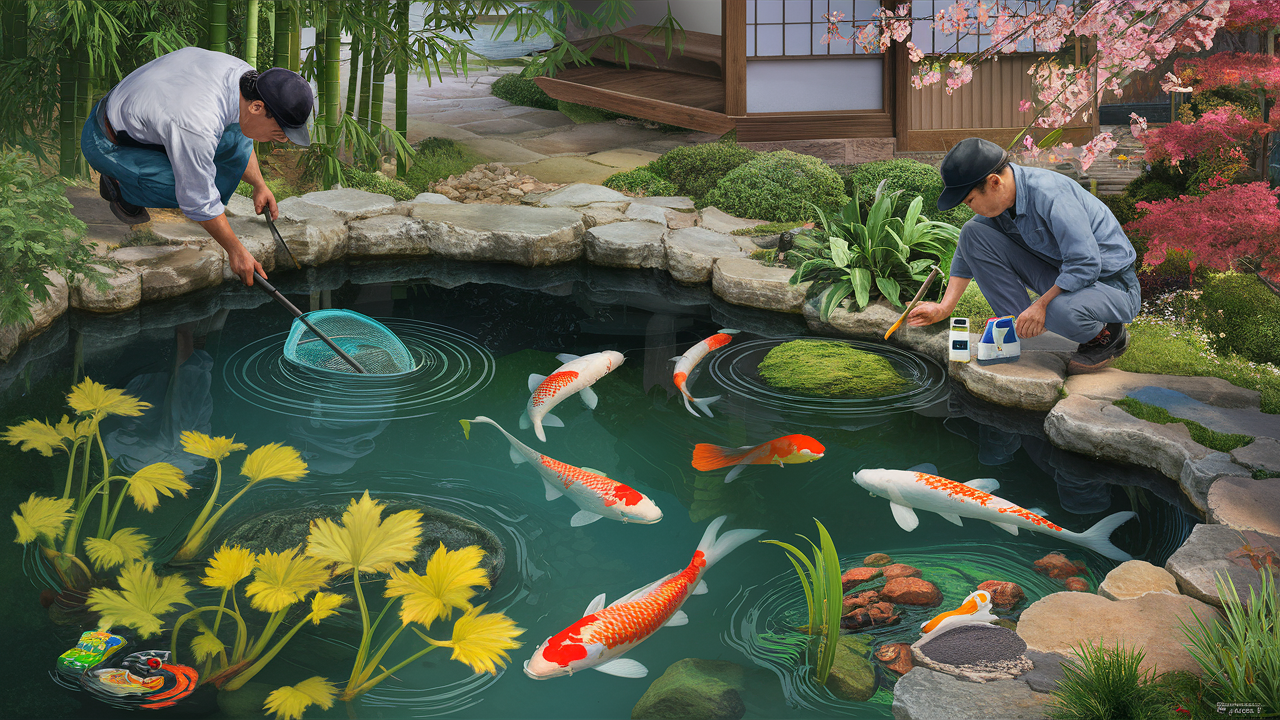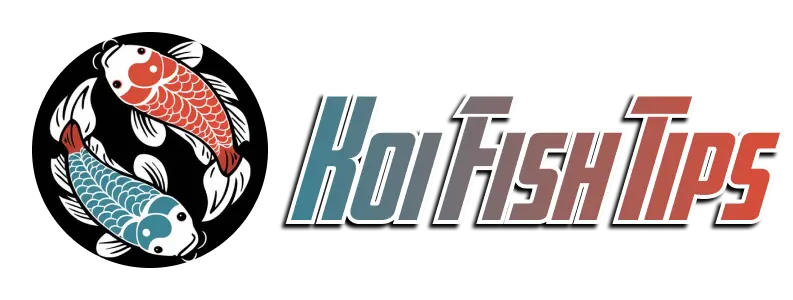Koi pond upkeep is a crucial aspect of owning these aquatic jewels, ensuring their longevity and the well-being of your koi. At Koi Fish Tips, we believe in empowering pond owners with the knowledge and tools to create a thriving aquatic ecosystem. This comprehensive guide will delve into the essential aspects of koi pond upkeep, providing you with the insights and practical tips to transform your pond into a serene oasis.
Understanding the Importance of Koi Pond Upkeep
Imagine a serene pond, its surface shimmering under the sun, its water crystal clear, and its koi gracefully gliding through the depths. This idyllic image is only possible with consistent and meticulous upkeep.
Koi pond upkeep is not just about aesthetics; it’s about ensuring the health and happiness of your koi. Neglecting pond maintenance can lead to a cascade of problems:
- Water Quality Deterioration: Unfiltered waste, decaying plant matter, and excess nutrients can pollute the water, creating an unhealthy environment for your koi.
- Disease Outbreaks: Poor water quality can weaken the immune system of your koi, making them susceptible to diseases and parasites.
- Algae Blooms: Excess nutrients in the water can trigger excessive algae growth, blocking sunlight and hindering the growth of aquatic plants.
- Koi Stress: Unbalanced water parameters and poor living conditions can lead to stress in your koi, impacting their growth, health, and lifespan.
Essential Elements of Koi Pond Upkeep
Water Quality Management
Filtration
The heart of any healthy koi pond is a robust filtration system. Filtration removes waste, debris, and excess nutrients from the water, ensuring optimal water quality.
- Mechanical Filtration: This stage removes large particles like leaves, debris, and fish waste. Common types include pre-filters, settling chambers, and drum filters.
- Biological Filtration: This stage utilizes beneficial bacteria to break down harmful ammonia and nitrite into less toxic nitrates. Bio-filters, such as those containing filter media like bio-balls, provide a surface area for bacteria to colonize.
- Chemical Filtration: This stage removes dissolved organic compounds, metals, and other pollutants. Activated carbon filters are commonly used for this purpose.
Water Changes
Regular water changes are essential for maintaining optimal water quality.
- Frequency: The frequency of water changes depends on the size of your pond, the number of koi, and the type of filtration system. Generally, partial water changes of 10-20% should be performed weekly or bi-weekly.
- Water Quality Testing: Regularly test your water parameters using a reliable test kit. Monitor levels of ammonia, nitrite, nitrate, pH, and dissolved oxygen.
- Water Source: Use clean, dechlorinated water for your water changes. Chlorine can be harmful to koi.

Pond Maintenance
Cleaning
- Regular Debris Removal: Remove leaves, debris, and other organic matter from the pond surface and bottom regularly.
- Pond Bottom Cleaning: Vacuum the bottom of the pond periodically to remove accumulated debris and waste.
- Plant Maintenance: Trim and remove dead or decaying plant matter.
- Filter Maintenance: Clean or replace filter media as needed. Follow the manufacturer’s instructions for your specific filter system.
Pond Aeration
Adequate aeration is crucial for maintaining dissolved oxygen levels in your pond.
- Air Pumps: Use air pumps to introduce oxygen into the water.
- Waterfalls and Fountains: These features can also provide aeration and enhance the visual appeal of your pond.
Koi Health Management
Feeding
- High-Quality Koi Food: Feed your koi a high-quality, balanced diet specifically formulated for koi.
- Feeding Frequency: Feed your koi twice a day, in the morning and evening. Adjust the amount of food based on the water temperature and the activity level of your koi.
- Avoid Overfeeding: Overfeeding can lead to excess waste and water quality problems.
Disease Prevention
- Quarantine New Koi: Always quarantine new koi for at least two weeks before introducing them to your main pond.
- Regular Inspections: Inspect your koi for any signs of illness, such as lethargy, loss of appetite, or unusual behavior.
- Prompt Treatment: If you suspect your koi is sick, consult a qualified veterinarian or fish specialist for diagnosis and treatment.
How to care for a koi pond?
Maintaining a koi pond is a rewarding journey. It’s a constant learning experience, a testament to your dedication to creating a thriving aquatic ecosystem. By following these guidelines, you can ensure your koi pond remains a sanctuary of beauty, tranquility, and vibrant life.
Remember: Koi pond upkeep is an ongoing process. Be proactive, stay informed, and enjoy the serenity that your koi pond brings to your life.
Koi Fish Tips is here to guide you every step of the way. We offer a wealth of resources, including articles, videos, and expert advice, to help you create and maintain a healthy and beautiful koi pond. Visit our website today to learn more!
Frequently Asked Questions about Koi Pond Upkeep
How often should I change the water in my koi pond?
The frequency of water changes depends on the size of your pond, the number of koi, and the type of filtration system. Generally, partial water changes of 10-20% should be performed weekly or bi-weekly.
What are the signs of a healthy koi pond?
A healthy koi pond will have clear water, vibrant aquatic plants, and active, healthy koi. The water should be free of debris and have balanced water parameters.
What are the best plants for a koi pond?
Some popular koi pond plants include water lilies, lotus, water hyacinths, and water iris. These plants provide oxygen, shade, and a natural habitat for your koi.
How do I prevent algae blooms in my koi pond?
Algae blooms can be prevented by maintaining good water quality, limiting excess nutrients, and providing adequate shade. You can also use algaecides to control algae growth.
What are the common diseases that affect koi?
Koi are susceptible to various diseases, including parasites, bacterial infections, and fungal infections. Regular inspections and prompt treatment are essential for preventing and managing koi diseases.
How do I know if my koi is sick?
Signs of illness in koi include lethargy, loss of appetite, unusual behavior, discoloration, and lesions. If you suspect your koi is sick, consult a qualified veterinarian or fish specialist.
What is the best way to winterize my koi pond?
Winterizing your koi pond involves preparing it for cold weather conditions. This typically involves lowering the water level, adding de-icer, and protecting the pond from freezing.
How do I choose the right koi for my pond?
Consider the size of your pond, the water temperature, and your personal preferences when selecting koi. Choose koi that are healthy, active, and compatible with your pond environment.
What are the best resources for learning more about koi pond upkeep?
There are many resources available for learning about koi pond upkeep, including books, websites, and online forums. You can also consult with experienced koi breeders and pond specialists.
Where can I find a qualified koi veterinarian?
You can find a qualified koi veterinarian by contacting your local animal hospital or searching online directories. Ensure the veterinarian has experience treating koi and other aquatic animals.
Conclusion
Koi pond upkeep is a rewarding journey that requires dedication, knowledge, and a passion for creating a thriving aquatic ecosystem. By following these guidelines and seeking expert advice, you can transform your pond into a serene oasis, filled with vibrant life and captivating beauty. Remember, Koi Fish Tips is here to support you every step of the way. Let’s create a pond that you and your koi will cherish for years to come!

Bài viết liên quan
Shrimp Tank Mates: Creating A Harmonious Underwater Ecosystem
Embarking on the exciting journey of shrimp keeping often involves creating a thriving and harmonious [...]
Jul
How Many Koi Per Gallon? A Guide For Your Pond Paradise
One of the most common questions we receive is “How many koi per gallon?” This [...]
Jul